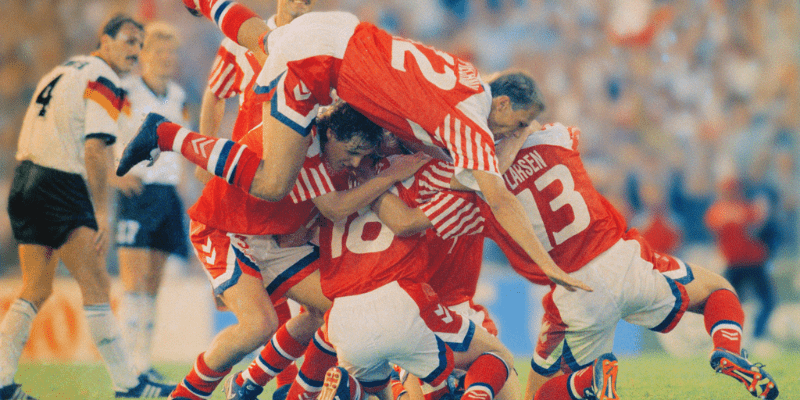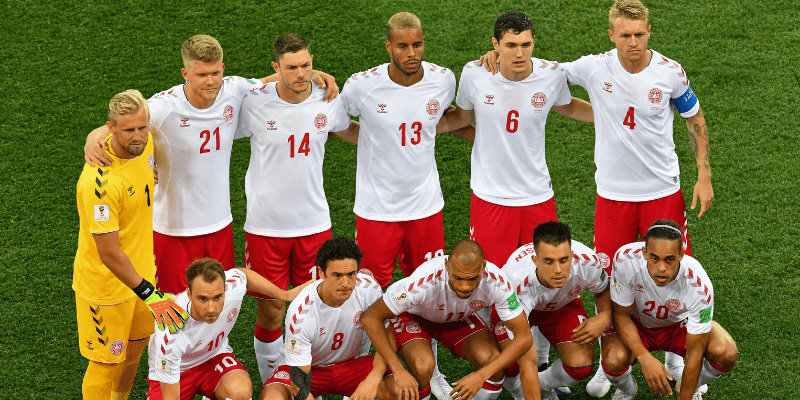In football, every nation endures highs and crushing lows. For Denmark’s national team, the shadow of its biggest loss in Denmark national team history still lingers in the archives. But what exactly is that defeat? And how has it shaped Danish football’s narrative? In this article, IndiGoal will accompany you to explore the story behind that humiliating scoreline, unpack its context, trace how Denmark rebounded, and assess whether any modern-day results have ever come close.
The Heaviest Defeat: Germany 8-0 Denmark (16 May 1937)

The single most brutal defeat in Danish football is documented as an 8–0 loss against Germany. This match took place in Breslau (then Germany, now Wrocław, Poland) on 16 May 1937 and remains officially recorded as the heaviest defeat in the nation’s international history.
Match context and circumstances
- It was a friendly match—not a tournament or qualifier—yet the result inflicted deep humiliation.
- Germany dominated, a forward named Otto Siffling scored five of those eight goals, wreaking havoc on the Danish defense.
- At the time, international football was still evolving; some repeated mismatches and lopsided scores were more common in earlier eras. But even by those standards, an 8-goal drubbing stood out.
Aftershock and impact
This defeat left scars—not just on the scoreboard but in national pride. It exposed glaring tactical and structural gaps in the Danish setup of the 1930s. In the decades that followed, Denmark would slowly modernize its approach, but this match remains a cautionary landmark in its footballing memory.
Are There Other Candidates? A Look at Rival Claims
Whenever one talks about “biggest loss,” skeptics often dig through obscure records, friendly games, or even unofficial matches to challenge the accepted result. Let’s examine some alternative claims or myths.
14–2 Iceland (1967)?
On forums and casual lists, a “14–2 Iceland (1967)” result sometimes pops up under Denmark. But that is almost certainly erroneous or misattributed, and no credible historical source confirms such a scoreline for the Danish men’s senior national team. (Indeed, it surfaces in fan discussions but lacks verification.)
8–0 Poland (1948)?
Some threads on internet football forums claim Denmark lost 8–0 to Poland in 1948. However, official match databases and authoritative records do not confirm such a match as part of Denmark’s “A” international fixtures. These tend to be speculative or informal match listings.
Other heavy losses
In more recent decades, Denmark has suffered heavy knockout defeats (e.g. in major tournaments), but none approach an eight-goal margin. In the post-war era, most losses remain within the 2–4 goal range. A contemporary severe collapse of that magnitude would be front-page news—and there is no evidence of one.
Given the weight of reliable sources—match databases, football historians, record compilers—the 8–0 defeat vs. Germany in 1937 stands unrivalled as Denmark’s worst ever.
Tracing Denmark’s Defensive Fragility Before and After 1937

To understand how such a loss happened—and has not been repeated—one must look at the evolution of Danish football over eras.
The early decades: amateurism, tactical infancy
In the early 20th century, Denmark’s football was largely amateur and regionally organized. Training, physical preparation, tactics, and player specialization lagged behind major powers like Germany, England, or Italy. In such a landscape, mismatches were stark.
The 1937 defeat reflects that gap. Germany was already progressing in tactical sophistication; Denmark could not match it in formation discipline, fitness, or game tempo.
Post-1937 recovery and resilience
After the disaster, Danish football slowly reorganized. Institutional reforms, better coaching, and exposure to international football helped tighten gaps. Over time, as Danish players began playing abroad and bringing back tactical knowledge, the level improved. In the post-World War II era, Denmark avoided repeat catastrophes.
By contrast, modern Danish teams are well-structured, defensively sound, and capable of radical comebacks. While occasional slip-ups occur, the system rarely permits total collapse.
Psychological memory
That defeat also became a historical milestone. It reminds fans and players that football is unforgiving; it underscores how far Danish football has come. Coaches may still reference it as a cautionary tale: neglect fundamentals, and you can be humiliated.
Why the 1937 Result Still Matters Today
Why do fans, journalists, and record-keepers care about a match from 1937? Because football history is not just nostalgic—it offers perspective. The biggest loss in Denmark national team history is a symbolic boundary—how bad things once were, and how far the national program has evolved.
It reminds us:
- Even storied nations have faced catastrophic days.
- Defensive discipline and organizational structure matter.
- No margin is safe in international football.
For modern Danish teams—filled with talents like Christian Eriksen, Joachim Andersen, and rising stars—history serves as both humility and motivation.
Other Noteworthy Defeats (Post-1937)
While none breach the eight-goal mark, Denmark has endured tough days. Let’s highlight some of the most painful:
- In the 1980s and 1990s, Denmark sometimes lost by 3 or 4 goals in qualifiers or friendlies against powerhouses.
- In major tournaments, elimination often comes in tight games rather than blowouts.
- Matches against Germany or the Netherlands often produce stiffness or tactical losses, but not the kind of collapse seen in 1937.
These results, though unflattering, are within the range of competitive soccer and show the modern maturity of the national setup.
Common Questions Around This Topic
Q: Could there be an even worse match in unofficial games or youth levels?
A: Possibly, but in terms of official full international matches, none credible records support a loss worse than 8–0 for Denmark’s senior team.
Q: Has a Danish women’s national team ever suffered a bigger defeat?
A: That is a different record domain entirely. The “biggest loss in Denmark national team history” typically refers to the men’s senior side. The women’s side has its own records.
Q: Is the 8–0 defeat ever disputed by historians?
A: While some historians debate minor match-line data, the 8–0 scoreline and opponent (Germany, Breslau) are consistently affirmed across major football record institutions.
Q: Does losing heavily in a friendly count as much as in a tournament?
A: In raw statistics, yes—loss is loss. But in psychological and sporting significance, a heavy defeat in a competitive match might sting more. That said, since Denmark’s worst result came in a friendly, it suggests the national team could be vulnerable even without competitive stakes.
Implications For Denmark’s Identity And Legacy

A nation’s worst defeat becomes part of its lore. For Denmark:
- It framed a before-and-after in football modernization.
- It underscores humility: even underdogs can be crushed.
- It serves as a gauge: Danish teams now often pride themselves on not just competing but defending with steel.
When players don the red-and-white today, they carry that memory with them—virtually guaranteeing they never want to approach such a low point again.
Conclusion
The biggest loss in Denmark national team history remains the 8–0 defeat to Germany in 1937—a crushing, emblematic low in the country’s football journey. More than an embarrassing scoreline, it is a historical marker: reminding us of the fragility of sport, the necessity of structure, and the strength it takes to rebuild.
At IndiGoal, we believe history teaches the future. If you’d like to dive deeper—into Denmark’s greatest wins, player biographies, or turning points in Nordic football—stay tuned here. And now that you know the darkest day in Danish football history, share the article, challenge your friends’ football trivia, or ask us for the biggest wins next.






